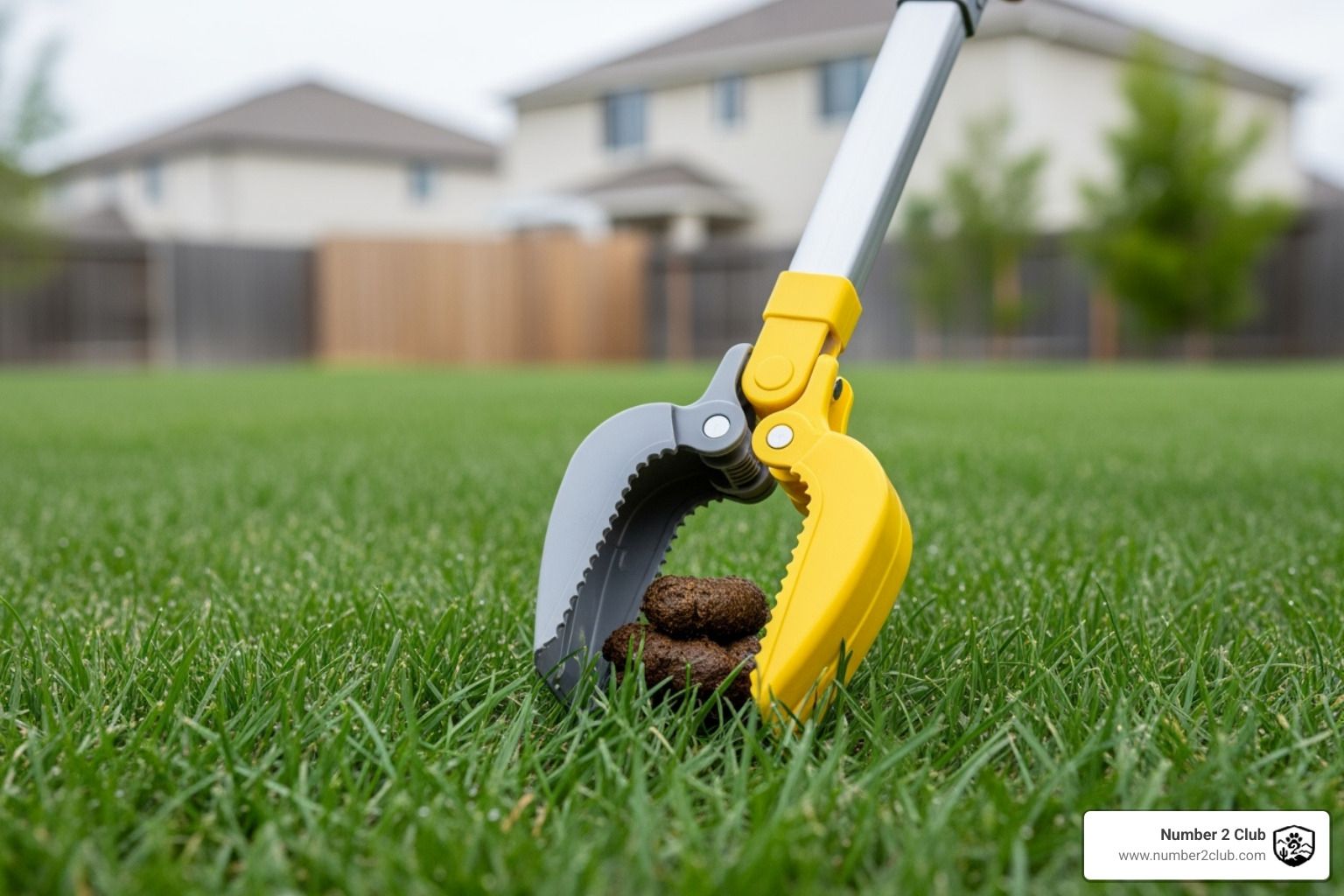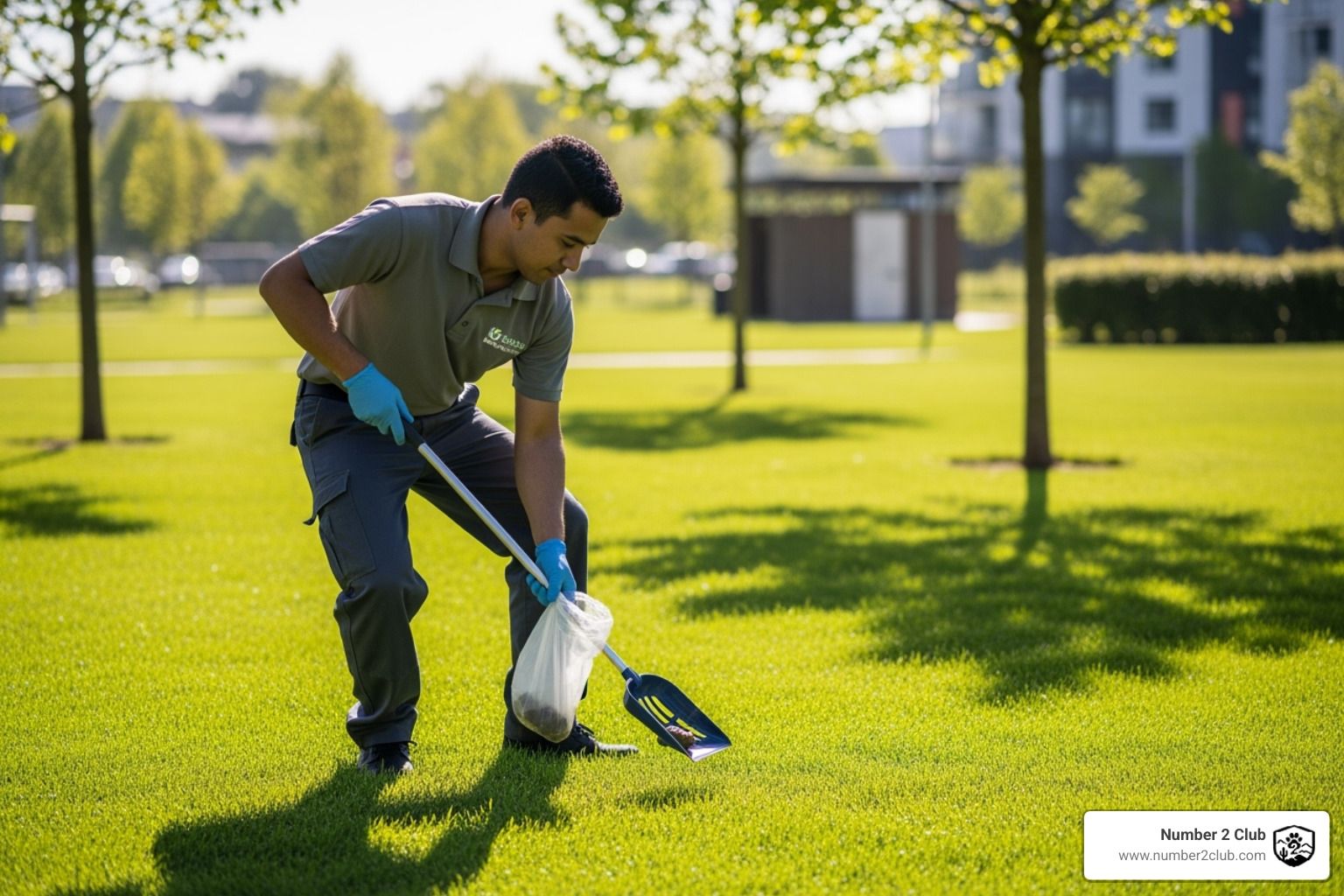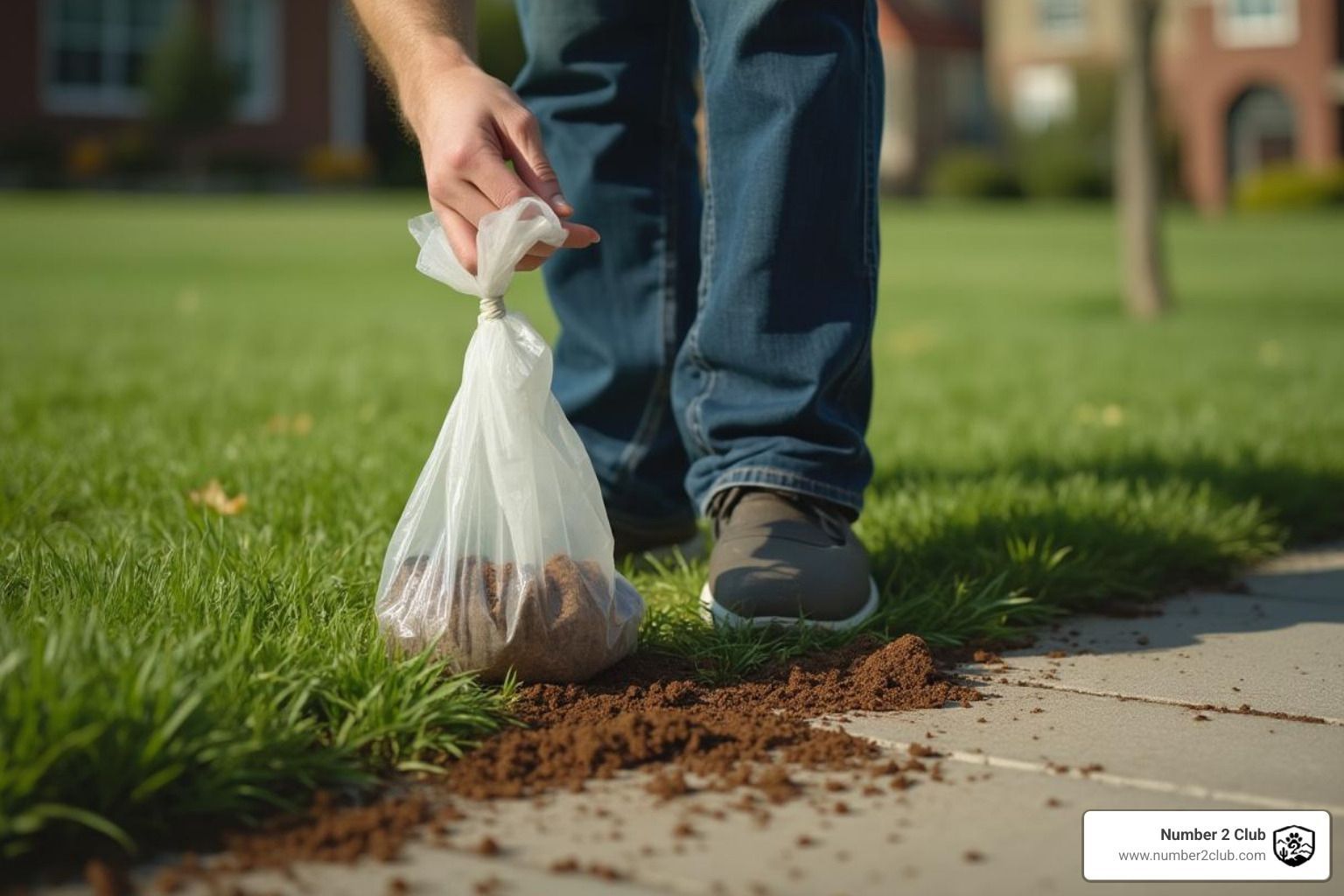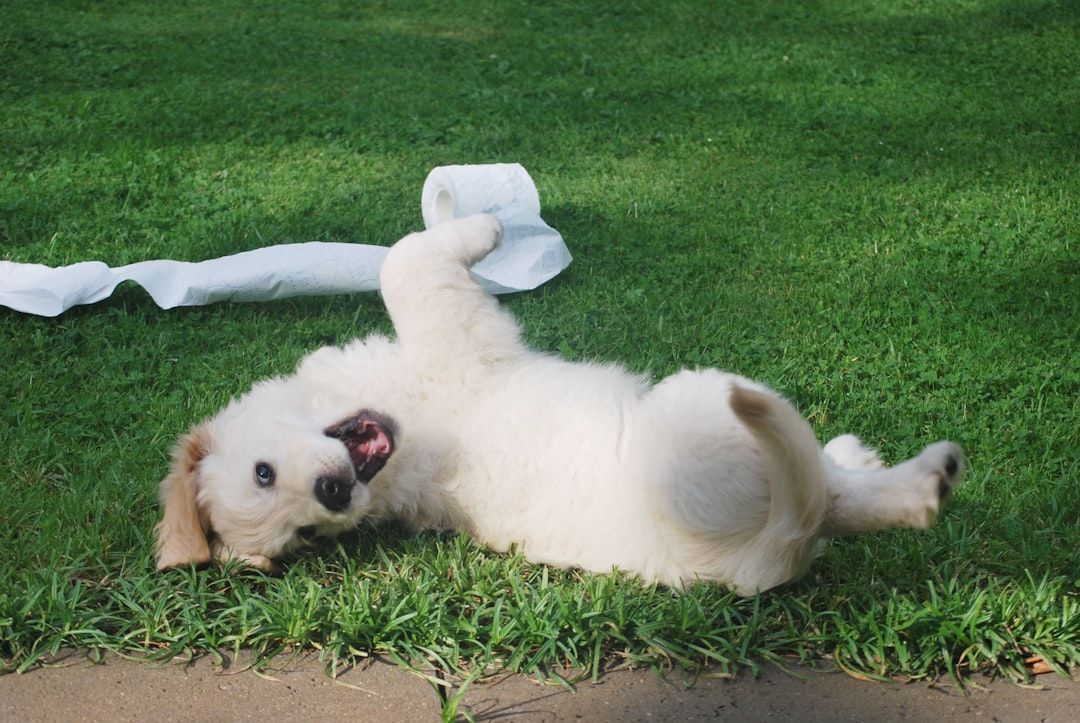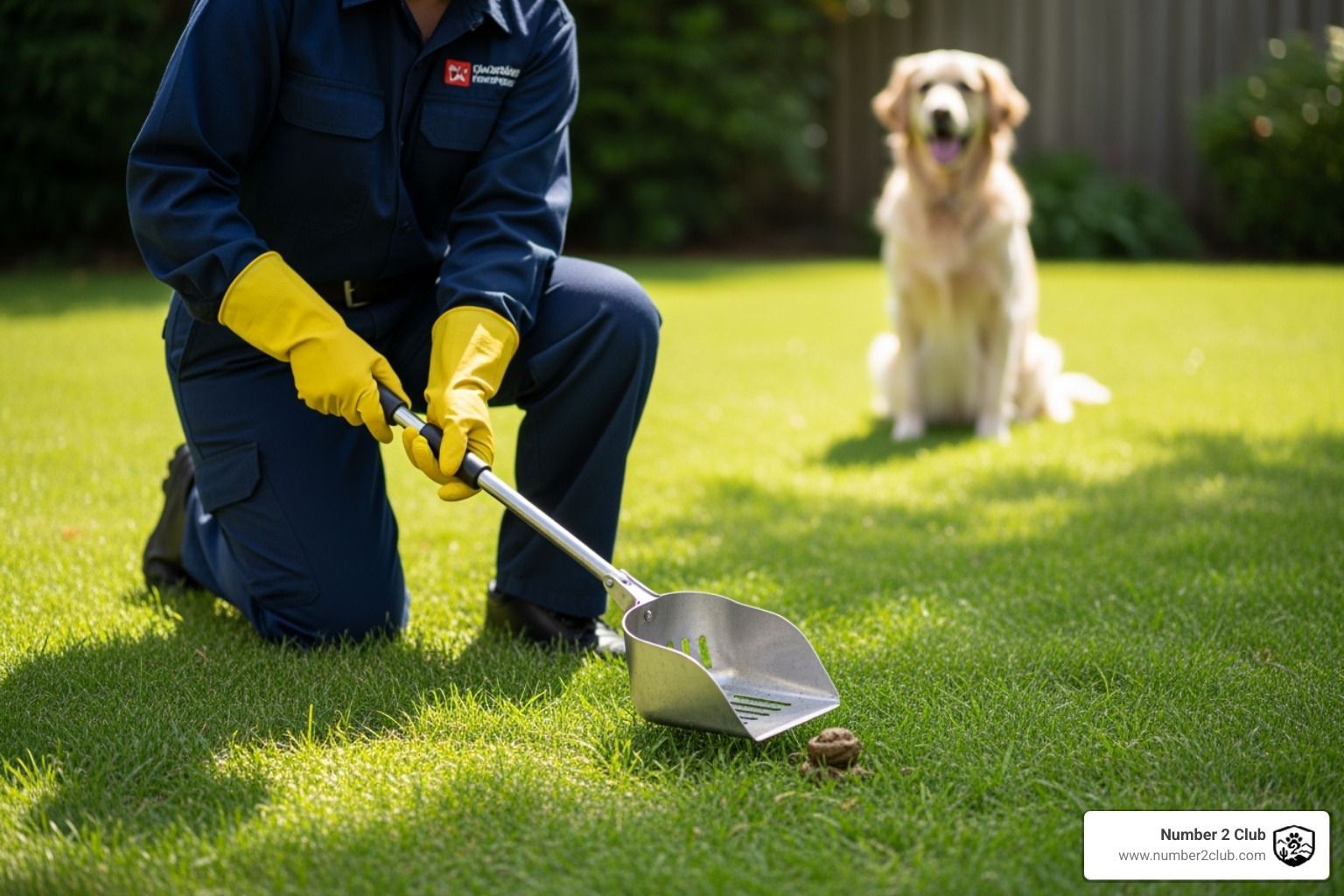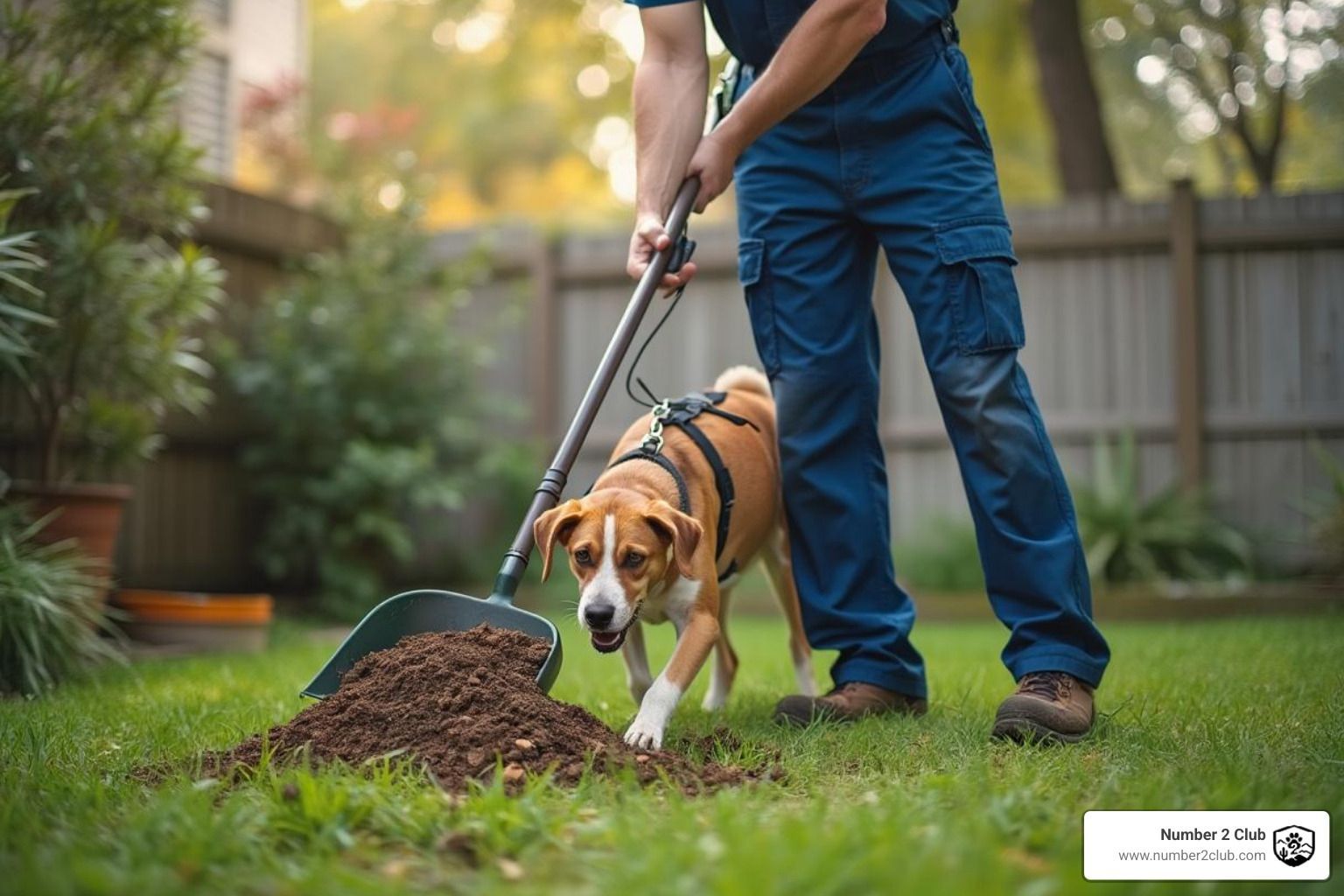The Complete Guide to Dog Waste Removal Services
Why Dog Waste Removal Is Essential for Every Pet Owner
Dog waste removal is a crucial service that keeps yards clean, protects public health, and maintains community standards. With 4 out of every 10 American households owning dogs, proper waste management affects millions of families nationwide.
Quick Answer: Dog Waste Removal Options
• Professional Services: $10-15 per visit, weekly pickup, no contracts required
• DIY Method: $60 startup cost for bucket, scooper, bags, and bleach
• Eco-Friendly: Composting systems and biodegradable disposal options
• Business Opportunity: $2,000+ monthly revenue potential with low overhead
The numbers tell a stark story. The average dog produces 274 pounds of waste per year - that's three-fourths of a pound daily. A single gram contains 23 million fecal coliform bacteria that cause serious health problems. Even more alarming: just 2-3 days of droppings from 100 dogs can force the EPA to close an entire bay and surrounding watersheds to swimming and fishing.
Whether you're a busy homeowner who wants to "skip the mess and enjoy your yard again" or someone considering the booming pet waste removal industry, understanding your options saves time, money, and protects your family's health.
I'm Joseph Lopez, and through my experience building multimillion-dollar service businesses, I've seen how proper dog waste removal systems create healthier communities while generating substantial revenue for entrepreneurs. This guide covers everything from choosing the right service to starting your own profitable waste removal business.
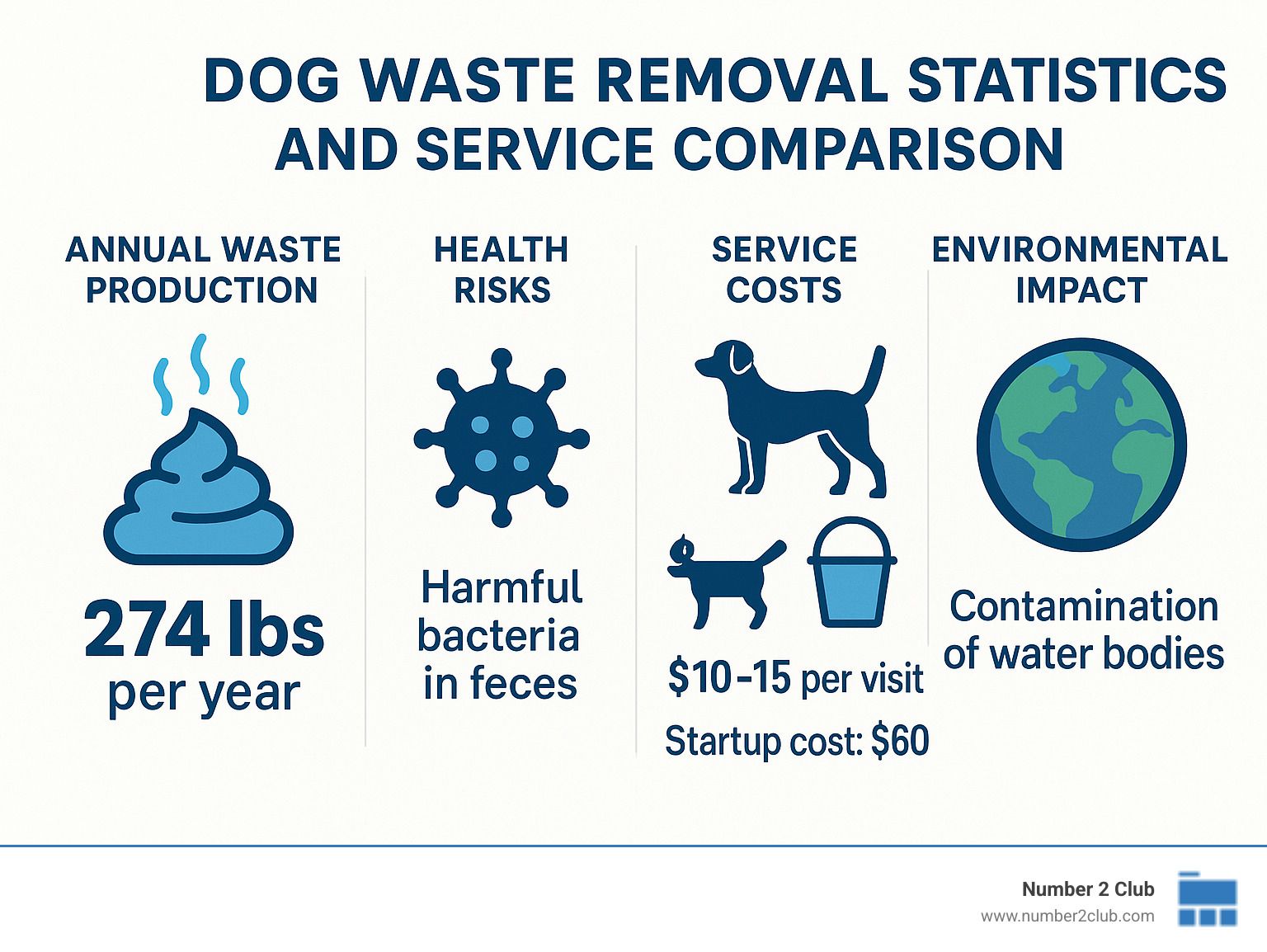
Why Proper Waste Management Matters
Let's be honest - nobody wants to talk about dog poop, but ignoring it creates serious problems that go way beyond stepping in something unpleasant. When dog waste sits in your yard, it becomes a health hazard that affects your family, neighbors, and the entire community.
Think about those staggering numbers from earlier: 23 million bacteria in just one gram of waste. That's not just gross - it's genuinely dangerous. These aren't harmless bacteria either. We're talking about fecal coliform bacteria that cause real illness, plus parasites like roundworms and Giardia that can make your kids seriously sick.
The problem gets worse when it rains. All that contamination doesn't just disappear - it flows into storm drains and heads straight to rivers, lakes, and beaches. The EPA has documented cases where accumulated pet waste forced them to close entire bays to swimming and fishing. That's how powerful this contamination can be.
Professional dog waste removal services understand these risks and take them seriously. They use proper sanitation protocols, disinfect their tools, and follow strict disposal guidelines that most homeowners don't even know exist.
Public-health impact of dog waste removal
The health risks hit children the hardest. Kids love playing in yards, and they're not exactly careful about washing their hands afterward. When soil gets contaminated with roundworms, children can develop serious eye problems - even blindness in severe cases. Giardia causes weeks of digestive misery that no parent wants their child to endure.
Here's what many people don't realize: these parasites stick around for years. Even after the visible waste disappears, the contamination remains in your soil. Wind, insects, and water spread it to neighboring properties, creating a domino effect throughout the neighborhood.
The bacteria counts in contaminated yards often exceed safe levels by hundreds of times. This isn't just about your property anymore - it becomes a community wellbeing issue that affects everyone nearby.
Professional services break this cycle by removing waste before contamination spreads. They understand that proper dog waste removal protects not just your family, but contributes to children safety throughout the neighborhood. Plus, nobody has to deal with persistent odor control problems that strain relationships with neighbors.
Environmental stakes of dog waste removal
The environmental damage extends far beyond your backyard. When waste washes into storm systems, it creates nitrogen overload in waterways that triggers massive algae blooms. These blooms suck oxygen from the water, killing fish and destroying entire ecosystems.
Groundwater risk represents another serious concern. Contamination can seep into drinking water supplies, affecting communities for years. The watershed closure scenarios documented by the EPA show how quickly pet waste pollution can escalate from a neighborhood nuisance to a regional environmental disaster.
Even your lawn suffers. Concentrated waste creates lawn burn from too much nitrogen, leaving dead patches that require expensive reseeding. What starts as a simple cleanup issue becomes costly property damage.
The good news? Proper dog waste removal prevents all these problems. Professional services ensure waste gets disposed of safely instead of flowing into storm drains or contaminating soil. Scientific research on pet-waste bacteria consistently shows that systematic waste management dramatically reduces environmental contamination.
This is why more communities are recognizing that dog waste removal isn't just a convenience service - it's essential infrastructure for public health and environmental protection.
How Dog Waste Removal Services Work
The dog waste removal industry has transformed from a novelty service into a thriving business that prioritizes both convenience and community health. These services operate much like other home maintenance companies, with trained technicians following established routes and maintaining consistent schedules that busy families can count on.
Most companies focus on weekly pickup as their bread and butter service. This frequency prevents waste accumulation while keeping yards consistently clean and odor-free. The beauty of professional services lies in their systematic approach - they show up whether it's raining, snowing, or blazing hot outside, so you never have to worry about missed cleanups.
The no-contract plans offered by most services reflect the industry's confidence in customer satisfaction. Companies know that once families experience the freedom of never scooping poop again, they rarely cancel. This approach builds trust and allows customers to try services without long-term commitments.
Modern scheduling apps have revolutionized the customer experience. You'll receive confirmation texts, weather delay notifications, and completion reports right on your phone. Need to reschedule because you're having a backyard party? Most apps let you adjust service dates with just a few taps.
The satisfaction guarantee isn't just marketing fluff - it's standard practice. If technicians miss anything or you're not completely happy, reputable companies return for free re-service. This commitment to quality has helped the industry maintain excellent customer retention rates.
Typical dog waste removal process
Route planning represents the backbone of efficient service delivery. Professional companies map out neighborhoods to minimize travel time between stops, allowing technicians to serve more customers while maintaining reasonable pricing. The best routes keep driving time under five minutes between properties.
The yard scan process separates professionals from casual cleanup efforts. Trained technicians don't just grab the obvious deposits - they systematically cover every area where dogs typically go. This includes checking under decks, behind bushes, along fence lines, and other spots homeowners often overlook.
Scoop and bag procedures follow strict sanitation protocols. Technicians use professional-grade tools designed for efficiency and hygiene. The double-bagging standard prevents leaks during transport and contains odors that could affect other customers on the route.
Tool disinfection happens between every single property visit. This crucial step prevents cross-contamination between yards and maintains the health standards that make professional services superior to DIY cleanup. Most companies use EPA-approved sanitizers that kill harmful bacteria and parasites.
Safe disposal methods vary by location but always follow local regulations. Some companies use customer trash cans with permission, while others transport waste to approved disposal facilities. The key is removing contaminated material from your property completely.
Customer reports close the loop on service delivery. Many companies send quick texts or app notifications confirming completion, noting any concerns like gate issues or aggressive pets, and providing easy contact for questions or feedback.
Dog waste removal pricing & packages
Per-visit costs typically range from $10-15 for single-dog households, making professional service surprisingly affordable when you consider the time savings and health benefits. The pricing reflects the specialized nature of the work and the convenience factor that busy families value highly.
Multi-dog households usually pay an additional $3-4 per extra dog, recognizing the increased time and waste volume involved. This scaling approach keeps services accessible for families with multiple pets while fairly compensating technicians for additional work.
Frequency tiers accommodate different needs and budgets. Weekly service remains most popular because it prevents accumulation and maintains consistently clean yards. Bi-weekly pickup works well for smaller dogs or less-active yards, while monthly service suits seasonal properties or customers with minimal outdoor space.
The first-time deep clean fee addresses properties with significant waste accumulation. New customers often have weeks or months of buildup that requires extra time to clear. This one-time charge covers the additional effort needed to restore yards to maintenance-level cleanliness.
Service add-ons like yard deodorizing, disinfectant spraying, and seasonal cleanup provide comprehensive property maintenance. These premium options increase value for customers while helping service providers build stronger relationships and higher revenue per customer.
Regional variations in pricing reflect local market conditions, disposal costs, and competition levels. Urban areas with higher operating expenses typically charge premium rates, while suburban markets often offer more competitive pricing due to route efficiency and lower overhead costs.
For detailed information about service packages and pricing options, check out our FAQ page where we answer the most common questions about professional dog waste removal services.
DIY vs Professional: Costs, Tools & Best Practices
When you're deciding between rolling up your sleeves or hiring professionals for dog waste removal, the math might surprise you. The DIY route starts with about $60 in equipment - not exactly pocket change, but manageable for most pet owners.
Your shopping list includes a sturdy 2-5 gallon bucket, a quality metal scooper, plenty of 13-gallon bags, and bleach for keeping everything sanitized. Here's where many people make their first mistake: buying a cheap plastic scooper. Trust me, you'll regret this decision the first time you're trying to pick up waste from dry grass and your tool keeps bending or breaking.
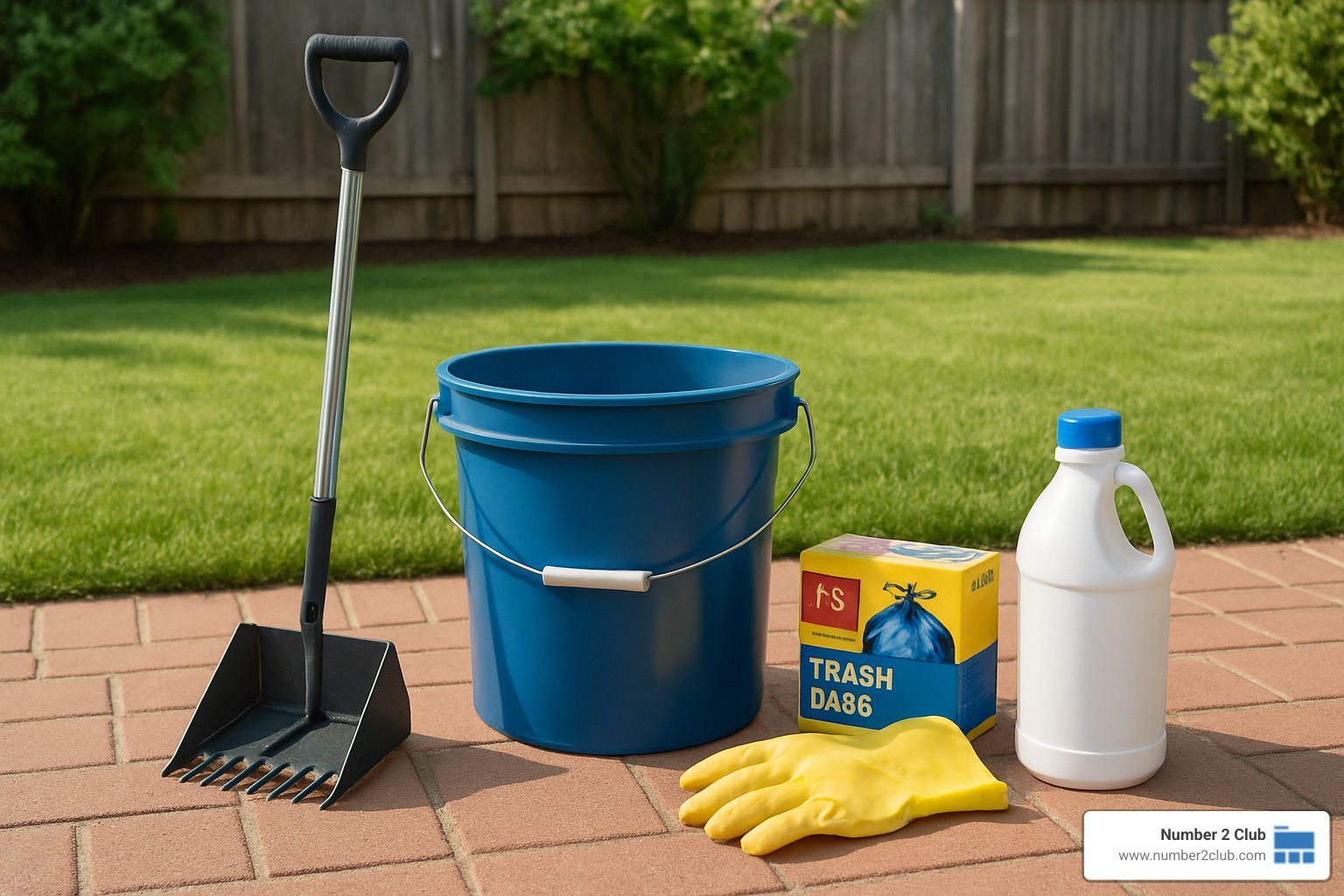
The time commitment reality check comes after your first few cleanup sessions. Most homeowners spend 15-30 minutes weekly doing thorough yard cleanup, and that's just the scooping part. Add in sanitizing your equipment, disposing of waste properly, and dealing with weather delays, and you're looking at a significant chunk of your weekend.
Don't forget the gear that keeps you safe and comfortable. Rubber gloves and protective boots aren't optional - they're essential for preventing contamination. A wide-brim hat saves you from sunburn during those hot summer cleanup sessions, and some dedicated DIYers even invest in hydration packs for longer yard work.
The Metal Pooper Scooper represents your most important investment. Quality units last for years and make the job infinitely easier than struggling with flimsy alternatives.
Starting a side-hustle in dog waste removal
The entrepreneurial opportunity in dog waste removal might be one of the best-kept secrets in small business. The startup costs stay refreshingly low, and some business owners report hitting $2,000+ monthly revenue within just three months of launching.
One entrepreneur I know grew to 39 residential properties in that same timeframe, proving that demand exists everywhere pet owners live. The secret isn't just getting customers - it's building efficient routes that maximize your earning potential.
Route efficiency determines everything in this business. When you optimize your schedule to minimize travel time between appointments, you can earn $50+ per hour during actual working time. Geographic clustering of customers becomes your best friend, turning scattered appointments into profitable routes.
Your branding decisions matter more than you might expect. Professional-sounding business names help you avoid the embarrassment factor that can limit your marketing reach. Consistent brand colors and quality uniforms signal the professionalism that justifies premium pricing over the neighbor kid with a shovel.
The legal side stays relatively simple. Most states require basic business licenses, liability insurance, and registered agent designation. Some entrepreneurs form LLCs for extra liability protection, though sole proprietorship works fine for smaller operations.
Marketing success comes from targeting the right places. Veterinary offices, pet supply stores, and targeted social media campaigns reach pet owners when they're already thinking about their furry family members. Once you establish quality service, word-of-mouth referrals drive sustainable growth.
Safety & sanitation best practices for dog waste removal
Personal protective equipment isn't negotiable when handling waste safely. Your minimum protection includes rubber gloves and closed-toe shoes, with many professionals adding protective eyewear and masks during windy conditions. Better safe than sorry when dealing with potential health hazards.
Tool disinfection between properties prevents spreading contamination from yard to yard. Bleach solutions or commercial sanitizers applied to all equipment surfaces do the job effectively. Some operators maintain completely separate tool sets to eliminate cross-contamination risks entirely.
The double-bag rule saves you from messy disasters during transport and storage. Inner bags contain the waste directly, while outer bags provide backup protection and odor control when you're driving between properties or heading to disposal sites.
Local trash ordinances vary significantly and determine how you can dispose of collected waste. Some municipalities prohibit pet waste in regular garbage collection, requiring you to find specialized disposal facilities or composting programs. Research these rules before starting your business or DIY routine.
Hand washing after every cleanup session prevents accidentally transferring contamination to food, personal items, or family members. Keep alcohol-based sanitizers handy for backup protection when soap and water aren't immediately available.
For businesses handling larger commercial properties, our commercial services page provides specialized solutions for complex waste management needs.
Eco-Friendly & Sustainable Disposal Options
Going green with your dog waste removal doesn't have to be complicated. More pet owners are finding that eco-friendly disposal methods help the environment while still keeping yards clean and healthy.
The truth is, traditional plastic bags can take decades to break down in landfills. That's why biodegradable bags have become so popular - they decompose within just a few months instead of hanging around for years. Yes, they cost a bit more upfront, but you're investing in your community's future.
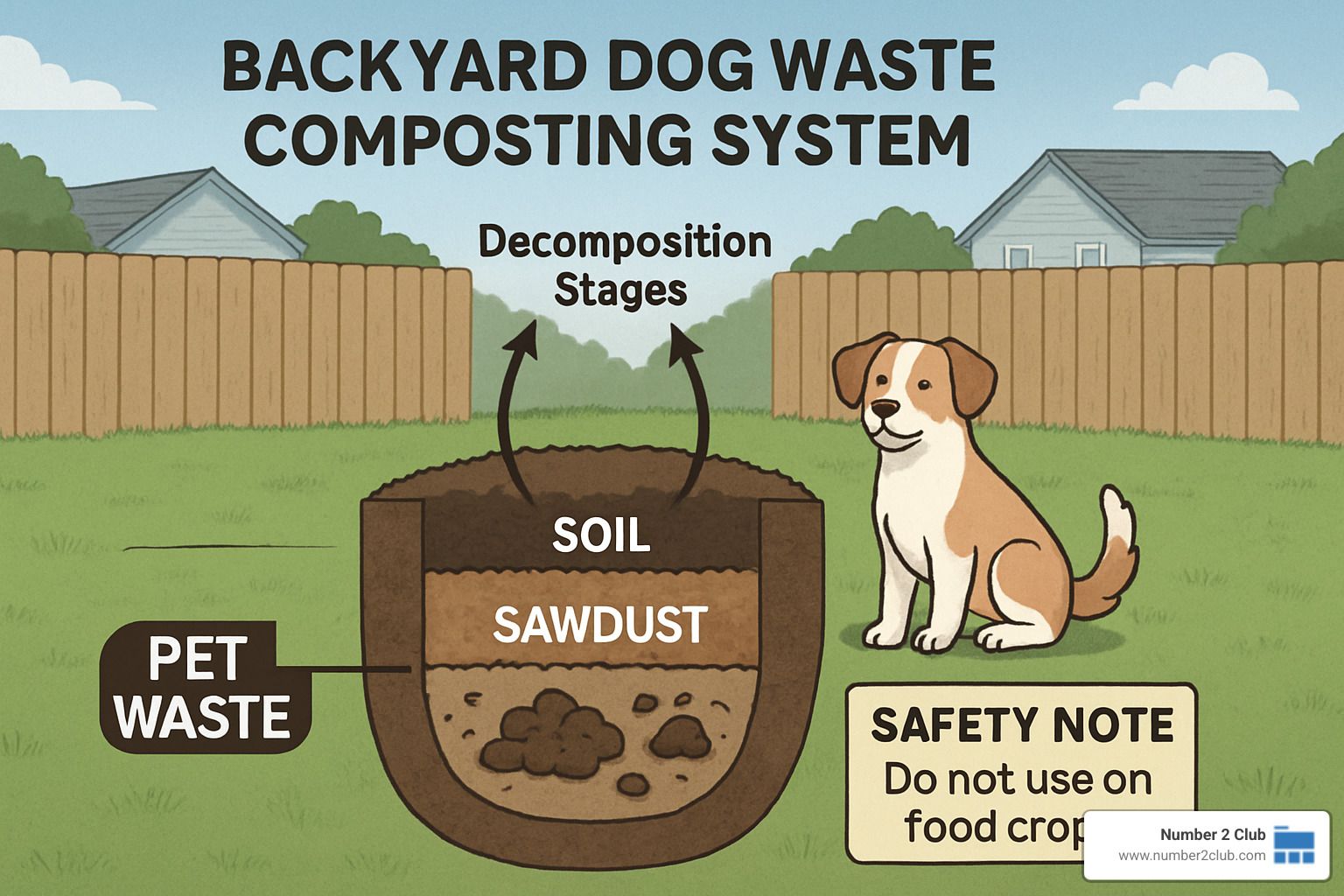
Dedicated pet waste composting bins offer another sustainable option, though they need careful management. Unlike your kitchen scraps composter, these systems require separate maintenance to prevent harmful bacteria from contaminating your garden materials.
For the more adventurous eco-warriors, worm farms can actually turn waste into valuable fertilizer. Red worms are surprisingly efficient at processing organic matter, though you'll need to monitor temperatures carefully to eliminate any nasty pathogens.
In-ground digesters work like a permanent waste processing system right in your yard. These underground units use natural bacterial action to break down waste over time. They work best if you live somewhere warm with soil that drains well.
The really exciting stuff is still coming. Biogas harvesters can actually convert pet waste into usable fuel, though this technology isn't quite ready for backyard use yet. Large-scale applications show real promise though.
Many neighborhoods are starting community green initiatives that coordinate composting programs or specialized collection services. It's amazing what happens when everyone works together on environmental solutions.
Can dog waste be recycled or composted safely?
Here's where things get technical, but it's important to understand the science. Safe composting requires maintaining temperatures above 140°F for extended periods. This heat kills the harmful bacteria and parasites that make pet waste dangerous.
The problem with home composting systems is consistency. Most backyard setups can't maintain these high temperatures reliably. Professional composting facilities have the specialized equipment and expertise to handle pet waste safely.
Even properly composted pet waste comes with garden use restrictions. Most experts strongly recommend keeping it away from vegetable gardens or anywhere you grow food. The contamination risks just aren't worth it, even after proper processing.
If you do decide to compost at home, layering techniques make a huge difference. Alternating waste with carbon-rich materials like dry leaves or sawdust creates better conditions for bacterial breakdown and helps control odors.
The USDA guidelines for animal waste processing spell out exactly what temperature and time combinations are needed for pathogen elimination. It's worth reading up on this if you're serious about home composting.
For detailed scientific information, check out this scientific research on composting pet waste that explains safe home composting systems.
Community benefits of sustainable dog waste removal
When entire neighborhoods accept sustainable dog waste removal, everyone wins. HOA compliance becomes much easier when communities adopt coordinated programs instead of leaving each homeowner to figure it out alone.
Park cleanliness improves dramatically with proper waste management systems. Families can actually enjoy public spaces without worrying about contamination risks or unpleasant surprises on the playground.
Property values get a real boost from clean, odor-free neighborhoods. Real estate agents will tell you that waste management problems can seriously affect both sale prices and buyer interest. Nobody wants to move into a smelly neighborhood.
Most importantly, resident satisfaction goes way up when communities take a proactive approach to pet waste. Instead of neighbors arguing about whose dog did what, everyone can focus on enjoying their clean, healthy environment.
Prevention beats cleanup every time. When communities work together on waste management, it creates a better quality of life for everyone - pet owners and non-pet owners alike.
Ready to explore sustainable options for your community? Learn more about our residential services and how we can help implement eco-friendly solutions neighborhood-wide.
Frequently Asked Questions about Dog Waste Removal
Let's address the most common questions homeowners ask about dog waste removal services. These answers help you make informed decisions about protecting your family's health and maintaining a clean yard.
What happens to the poop after dog waste removal?
The journey of your pet's waste doesn't end when the technician leaves your yard. Most professional services place double-bagged waste directly into your regular trash cans, following the same disposal path as your household garbage. This method works perfectly with municipal collection systems and keeps costs reasonable for everyone involved.
Some eco-conscious companies take an extra step by transporting waste to specialized composting facilities. These industrial-grade operations maintain the high temperatures needed to eliminate harmful bacteria and parasites - something backyard compost bins simply can't achieve safely.
Your local municipal rules determine what's allowed in your area. Most urban communities welcome pet waste in regular garbage collection, but some rural areas have stricter guidelines. Professional services stay current on these regulations so you don't have to worry about compliance issues.
Odor control during transport relies on proper double-bagging and sealed containers. Quality services invest in the right equipment because nobody wants their truck smelling like a kennel - and neither do their customers!
How often should I schedule a dog waste removal service?
Weekly pickup has become the sweet spot for most families. This frequency keeps your yard consistently clean without letting waste pile up between visits. It's like having a regular house cleaning schedule - consistent maintenance prevents bigger problems.
Families with multiple dogs often find that twice-weekly service works better, especially during hot summer months when decomposition happens faster. The extra visit prevents odor issues and keeps large-dog households comfortable.
Seasonal adjustments make sense in many climates. Winter service might stretch to every two weeks in freezing temperatures, while summer heat often calls for more frequent attention. Smart companies work with you to adjust schedules based on actual conditions rather than rigid contracts.
Special event cleanups provide one-time deep cleaning before parties, family gatherings, or when you're selling your home. These services transform even heavily contaminated yards into pristine spaces quickly - perfect for making great first impressions.
Are there local laws requiring dog waste removal?
Leash law violations often include hefty fines for leaving waste behind, with penalties ranging from $50 to $500 depending on your community. Park rangers and animal control officers take these violations seriously, especially in high-traffic areas where children play.
HOA bylaws frequently go beyond city requirements, mandating immediate cleanup with specific timeframes. These private community rules can include fines, warnings, and even legal action for repeat offenders. Professional services help residents stay compliant effortlessly.
City ordinances establish baseline standards that apply to everyone, though enforcement typically depends on neighbor complaints and visible violations. Most communities require immediate cleanup in public spaces and reasonable maintenance on private property.
Posted signage in many neighborhoods reminds pet owners about cleanup requirements, but the responsibility extends beyond just following signs - it's about being a good neighbor and protecting community healt
The bottom line? Whether legally required or not, proper dog waste removal protects your family, your neighbors, and your property values. Professional services make compliance automatic while giving you more time to enjoy your pets instead of cleaning up after them.
Conclusion
A clean yard isn't just about appearances - it's about creating a safe, healthy space where your family and pets can thrive together. Dog waste removal transforms the most unpleasant part of pet ownership into someone else's professional responsibility, giving you back precious weekend time to actually enjoy your furry friends.
Think about it: for the cost of a couple of coffee shop visits each month, you can eliminate a chore that nobody enjoys. Professional services starting around $12 per visit handle everything from the initial cleanup to proper disposal, following health protocols that most homeowners simply can't match at home.
The time savings alone make the investment worthwhile. Instead of spending half an hour every weekend with a scooper and bucket, you're free to play fetch, teach new tricks, or simply relax in your spotless yard. Your neighbors will appreciate the effort too - nothing builds community goodwill quite like responsible pet ownership.
Environmental stewardship matters more than ever, especially when it comes to protecting our water supplies and local ecosystems. Proper dog waste removal prevents the bacterial contamination that can literally shut down entire watersheds. Whether you choose professional service or tackle it yourself, the key is consistency - letting waste accumulate creates health hazards that affect everyone in your community.
For entrepreneurs, this industry represents a genuine opportunity to build something meaningful while helping neighbors solve a real problem. Those success stories of reaching $2,000+ monthly revenue aren't flukes - they reflect strong demand for reliable, professional service in an underserved market.
The bottom line is simple: life's too short to spend it cleaning up poop. Professional dog waste removal services handle the dirty work so you can focus on what really matters - building memories with your pets and family. For reliable service that puts your family's health and convenience first, check out our residential services. Number 2 Club takes care of the mess so you can get back to enjoying your beautiful, clean yard.


